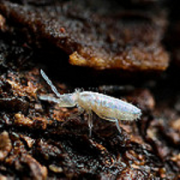Have you ever wondered what is going on in the soil beneath the surface of your pasture or crops? There is actually a whole world of microscopic living beings in the soil (e.g. photo of springtails feeding on bacteria) that is responsible for the nourishment of plants that grow on the soil surface. It is important that this world exists and that it is sustained, as it allows plants and crops to have a healthy environment. Plants are able to grow better in a healthy environment, which in turn allows farmers to produce good quality agricultural products.
One way in which you can see what lies beneath the soil surface is to do a very basic visual soil assessment on selected soil profiles with different crop and/or pasture types and compare them to the sustainability indicators. This would allow you to identify soils that need more management attention, and focus on improving them.
Two soil properties that are measured include structure and life. Porosity is measured as an indicator of structure and expressed as a percentage pore space; a porosity of 50% is good. A soil with a good porosity can be seen on the side of the soil profile where there is a crumbly soil structure with open space and smaller soil aggregates visible when disturbed with a knife. A well-structured soil also tends to be darker in colour as it is well correlated to organic matter and it holds more water. A poor structure is identified by a soil that has many large pieces of soil clods that are especially hard to break in your hand. The depth which roots grow to is also an indication of the soil structure, because a better structured soil will allow roots to grow deeper. Compaction layers can generally be identified along a line where roots stop growing, which is also indicative of a poor structured soil.
Soil life indicators that are measured include total carbon, total nitrogen, active carbon, potential mineralisable nitrogen, and soil respiration. A soil profile with tunnels indicates that soil life is moving through the soil. A darker soil colour indicates that there is more organic matter, which means that the soil life has broken down some of the plant material that is left over on the soil surface. Pink nodules on the roots of legumes such as clover or lucerne indicates that nitrogen-fixing bacteria in the root is actively converting atmospheric nitrogen into ammonia that can further be broken down to plant available nitrogen (i.e. ammonium). The presence of earthworms in the soil is also indicative of soil life.
Visually assessing the soil under pasture or crops, and comparing it to the sustainability indicators, can be a powerful tool to predict when soil quality starts deteriorating. This allows preventative management actions to be taken based on the poor visual soil indicators. This will reduce the negative impact of poor soil quality on pasture production and in future ensure long-term farming success.
- Milk, is it really just milk or so much more to it? - 2018-05-25
- Upside down thinking - 2018-04-19
- Happy soil life, happy grass, happy cows - 2018-04-04

